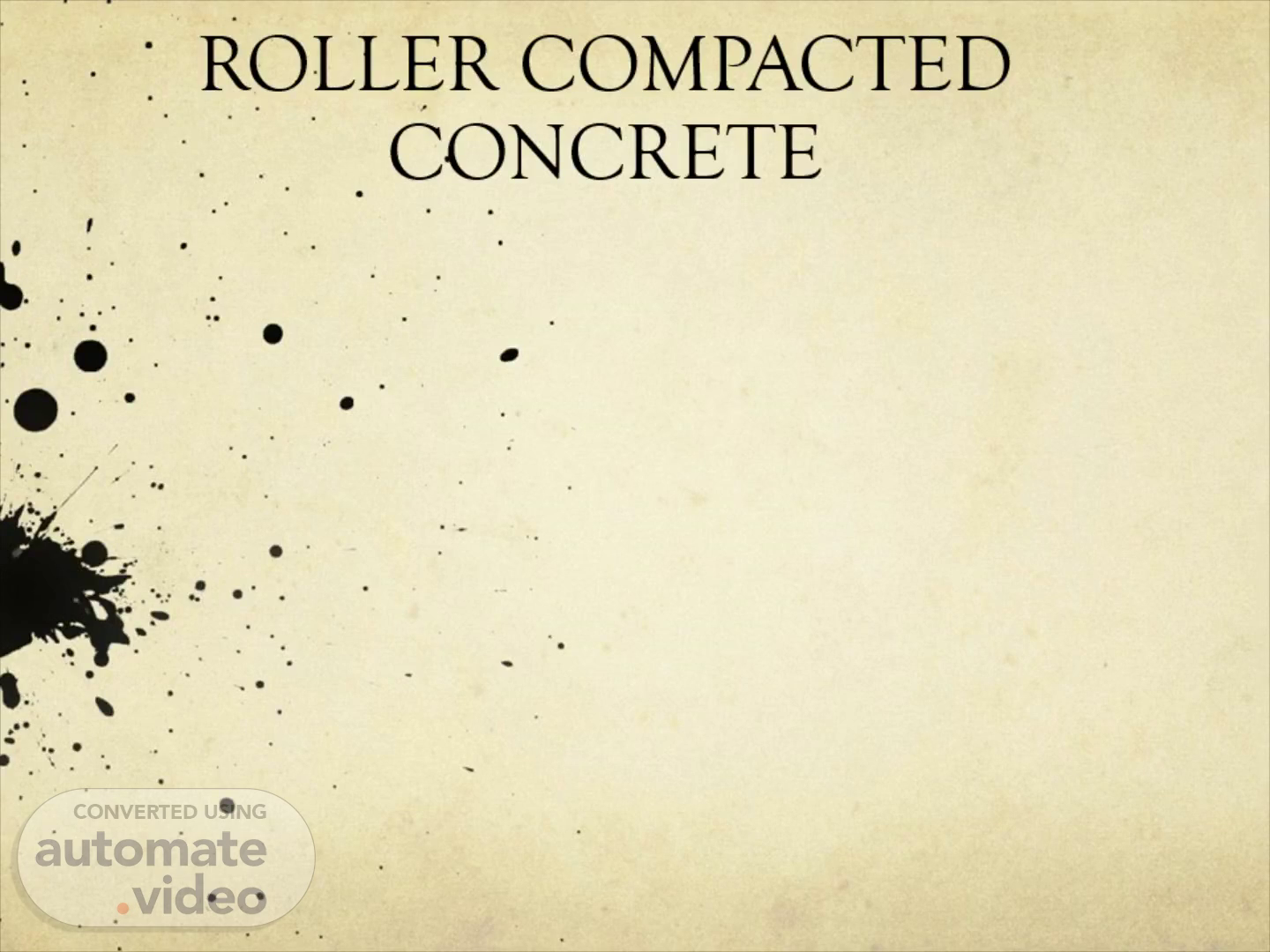
Page 1 (0s)
ROLLER COMPACTED CONCRETE. Roller-compacted concrete (RCC) is a super intense, zero-slump concrete with compressive qualities more noteworthy than 4,000 psi .. Roller -compacted concrete, or RCC, takes its name from the development technique used to fabricate it. It's set with regular or high-density asphalt paving equipment, then compacted with rollers..
Page 2 (48s)
The utilization of RCC can be followed back to the 1930's and '40's with the most recognizable material to the present asphalts being that from the 1970's logging industry where hard wearing, quick develop and ice resistant street building used RCC to incredible impact. From that point forward it has been utilized broadly for ports, harbor and compartment taking care of offices, administration streets, HGV stopping, hardstanding and hard shoulders. The primary fruitful use of Roller Compacted Concrete (RCC) innovation was shown in 1974 in the maintenance of fallen passage of Tarbela dam. Upon development it demonstrated that, these sort of concrete likewise can give required strength and solidness. It is additionally utilized in the development of world's biggest cash safe dam, Three-Gorges dam, China ..
Page 3 (2m 1s)
Roller-compacted concrete has a similar fundamental fixing as regular cement: coarse and fine aggregates, like rock or high measure of squashed stone, minimal sand, cement materials ( Portland concrete, fly ash, silica fume, and so forth), less water to hydrate, and, when suitable, compound admixtures however they are utilized in various extents. RCC commonly has a somewhat lower cement content than customary cement of comparative strength. The lower concrete substance can prompt a few reserve funds in material expenses. . RCC requires no structures, getting done, steel support or joint sawing. The combination of roller compacted substantial should be dry to the point of trying not to sink of the vibratory roller hardware, however wet to the point of permitting adequate dissemination of the binder mortar in concrete during the blending and vibratory compaction tasks. Roller compacted concrete is moved, set, and compacted utilizing earth and rockfill development hardware..
Page 4 (3m 13s)
PROCESS. RCC takes its name from the strategy used to fabricate it. • Blend - A RCC blending facility, for example, a pug mill, slant drum, or dry clump prepared blended plant, should have the proficiency to equally scatter the moderately modest quantity of water present in the firm, dry blend which looks like moist gravel. • Transport - Dump trucks transport the RCC blend from the plant to the customary or high-thickness black-top pavers. • Situation - The blend is set in layers (or lifts) 4-9 inches thick. • Compaction - Steel drum vibratory rollers compact the concrete. Compaction is the main importance step in RCC development since it gives thickness, strength, perfection, and surface. The interaction starts following position and proceeds until the pavement meets thickness necessities. The pavement should be restored to guarantee appropriate strength gain..
Page 5 (4m 20s)
Tough Durable Strong Sustainable Versatile Resist freezing and thawing Unique mix, Unique construction Good Performance Versatility.
Page 7 (6m 46s)
1. Minimal maintenance required 2. No pot holes 3. Resistance to oil spills, fuels and/or hydraulic fluids 4. Form work costs are minimized or eliminated because of the layer placement method . 5. High Volume Placement 6. It does not deform under heavy, concentrated loads 7. Can withstand high temperatures 8. Reduce cement consumption as the leaner concrete mix can be used. 9. The cost of transporting, placement, and compaction of concrete are minimized because concrete can be hauled by dump trucks; spread by bulldozers and compacted by vibratory rollers. 10. Economic 11. Eliminates early life rutting during overlay, reduces the risk of degradation at construction joints. 12. Efficient 13. The finished surface can be natural, power floated or brushed according to application.
Page 8 (7m 50s)
1. Although it is utilized to effectively plan RCC dams to be the most minimal expense substitute when contrasted with different sorts of dams, there are conditions that might make RCC all the more exorbitant. 2. Situations where RCC may not be proper is when total material isn't actually free, the establishment rock is of low quality or not near the surface, or where establishment conditions can prompt over the top differential settlement. 3. Dams fixed or built with roller compacted cement might experience the ill effects of water leakage. For that reason water stoppage layers will be thought of..
Page 9 (8m 40s)
Industrial and military facilities New Dam construction 3. Rehabilitation of existing dams 4. Airports 5. Storage 6. Sub -base of roads and airfield pavements Ports 7. Multi -modal yards 8. Distribution centers 9. Parking and storage facilities 10. Streets & highways, intersections, shoulders, turn lanes, bike paths 11. Manufacturing facilities, heavy haul roads, scrap yards 12. Power plants and other industrial facilities 13. Over -topping protection 14. Industrial slab floors 15. Airfield maintenance areas.
Page 10 (10m 19s)
Faster paving Reserve funds for tax payers Work savings Security Manageability.